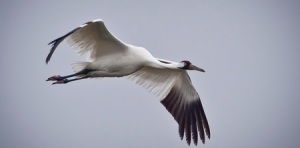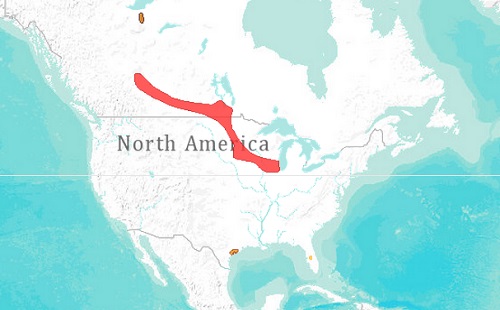0
Taxonomy

Migrating whooping crane. This species is considered as endangered by the IUCN Red List of Threatened Species.
- Kingdom: Animalia
- Phylum: Chordata
- Class: Aves
- Order: Gruiformes
- Family: Gruidae
- Genus: Grus
- Species: Grus Americana
0
Physical Features
- The whooping crane has snow white body feathers with black wingtips that can be seen when flying.
- The face has a black mask around the beak which is long and pointed so that it can reach into deep water and through vegetation.
- Their legs are long and dark.
- They have yellow eyes.
- Juveniles have brown feathers.
Distribution and Habitat
- The whooping crane is native to North America and is one of two species found in the continent, the other is the sandhill crane.
- The whooping crane habitat includes in wetlands, mudflats, marshes, fields, shallow lakes and lagoons.
- In 1941 there were 21 whooping cranes in the wild and 2 in captivity. As of 2011 there were 437 in the wild and 165 in captivity.
- There are three populations of whooping cranes:
- One self sustained western wild migratory population with breeding grounds in Wood Buffalo National Park in the Northwest Territories, Canada.
- One small introduced eastern migratory population with feeding grounds in Necedah National Wildlife Refuge in Wisconsin, USA. As of September 2014 this population had 99 birds.
- One non migratory introduced population in Kissimmee Prairie in central Florida.

Whooping crane distribution map. Source: IUCN Red List of Threatened Species.
Size and height
- It is the tallest bird in North America at 5 feet or 1.5 meters.
- Its wingspan measures 7.5 feet or 2.3 meters.
- Males average 16 pounds or 7.3 kilos and females 14 pounds or 6.2 kilos.
Behavior
- Whooping cranes migrate in small groups of 2 to 7 individuals and leave ground at staggered times.
- They use thermal currents which aids with their long migration.
- The main western wild population migrates in the spring from their feeding grounds in Wood Buffalo National Park in Alberta, Canada to the winter feeding grounds in Aransas National Wildlife Refuge in Texas.
- The eastern population was introduced in 2001 and migrates in the spring from their breeding grounds in Necedah National Wildlife Refuge in Wisconsin to Chassahowitzka National Wildlife Refuge in Florida.
- Whopping cranes make loud whooping cries to communicate with each other.
- They have elaborate courtship dances to attract mates.
Reproduction
- They begin to look for mates in their winter feeding grounds and continue to bond during their migration north.
- They have elaborate courtship dance to attract mates.
- They breed in their summer grounds in the north.
- The couple builds their nest together.
- The female lays 1 to 3 eggs in late April or May. The eggs are olive color and incubation lasts 30 days.
- Most of the times only one chick will hatch and it will stay with its parents for the first year which includes the flight back south in the winter.
Life Expectancy
- Whooping cranes are expected to live from 24 to 30 years in the wild and 35 to 40 years in captivity.
Diet
- These birds eat crabs, frogs, crayfish, fish, insects, berries, small reptiles, crustaceans, grains and marsh plants. Their favorite food is the blue crab from which they extract most of their energy.
Predators
- Among their natural predators are wolves, coyotes, foxes, lynx, bobcats, raccoons, golden eagles, common raven and alligators.
Threats
- Natural predators, power lines, towers, storms, wind turbines, illegal hunting and loss of wetland.
Conservation Status
- In 1941 there were 21 whooping cranes in the wild and 2 in captivity. The whopping crane was declared endangered in 1967. Since then Canadians and Americans have cooperated to save this bird from extinction.
- IUCN lists the whopping crane as “endangered”.
Did you know?
When the new population of whooping cranes was first reintroduced there were no adults to teach migration patterns. Instead humans using ultra light planes become the parents and teach chicks their first migration. It only takes one migration and birds will remember for life returning to their winter grounds every year.
References and further research
The Whooping Crane Eastern Partnership
U.S. Fish and Wildlife Service
International Crane Foundation
